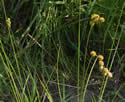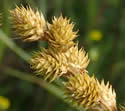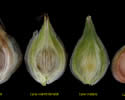Carex merritt-fernaldii (Fernald's Sedge)
| Also known as: | |
|---|---|
| Genus: | Carex |
| Family: | Cyperaceae (Sedge) |
| Life cycle: | perennial |
| Origin: | native |
| Habitat: | sun; dry sandy or rocky soil; rock outcrops, cliffs, rocky slopes, open meadows |
| Fruiting season: | June - August |
| Plant height: | 12 to 40 inches |
| Wetland Indicator Status: | none |
| MN county distribution (click map to enlarge): |  |
| National distribution (click map to enlarge): |  |
Pick an image for a larger view. See the glossary for icon descriptions.
Detailed Information
Spikes: 

![[photo of spikes]](/udata/r9ndp23q/pd3/carex-merritt-fernaldii-072017-7-t.jpg) 4 to 10 spikes each 7 to 15 mm (to ~½ inch) long, all at the tip of the stem, overlapping but not usually tightly crowded, the inflorescence (group of spikes) erect or slightly nodding and ½ to 2 inches long. All spikes are stalkless, erect to ascending, rounded to bluntly pointed at the tip, mostly rounded at the base and oval in outline, with staminate (male) flowers at the base and pistillate (female) flowers at the tip (gynecandrous). At the base of the lowest spike is a scale-like bract with a bristle-like tip that may be longer than the spike but does not overtop the terminal spike.
4 to 10 spikes each 7 to 15 mm (to ~½ inch) long, all at the tip of the stem, overlapping but not usually tightly crowded, the inflorescence (group of spikes) erect or slightly nodding and ½ to 2 inches long. All spikes are stalkless, erect to ascending, rounded to bluntly pointed at the tip, mostly rounded at the base and oval in outline, with staminate (male) flowers at the base and pistillate (female) flowers at the tip (gynecandrous). At the base of the lowest spike is a scale-like bract with a bristle-like tip that may be longer than the spike but does not overtop the terminal spike.
Leaves and stems: 

![[photo of sheath and ligule]](/udata/r9ndp23q/grass/carex-merritt-fernaldii_0720_094933-t.jpg) Leaves are alternate with 3 to 6 leaves on the lower third of the stem, 2.5 to 4.5 mm wide, shorter than the flowering stem, flat, hairless, rough along the edges especially near the tip. Stem leaf sheaths tightly wrap the stem and are mostly green nearly to the tip, the translucent, whitish tip extending up to 2.5 mm above the leaf base and is straight to concave across the top edge. Sheaths are covered in minute bumps (papillose) at least near the tip. The ligule (membrane where the leaf joins the sheath) is about as long as wide.
Leaves are alternate with 3 to 6 leaves on the lower third of the stem, 2.5 to 4.5 mm wide, shorter than the flowering stem, flat, hairless, rough along the edges especially near the tip. Stem leaf sheaths tightly wrap the stem and are mostly green nearly to the tip, the translucent, whitish tip extending up to 2.5 mm above the leaf base and is straight to concave across the top edge. Sheaths are covered in minute bumps (papillose) at least near the tip. The ligule (membrane where the leaf joins the sheath) is about as long as wide.
![[photo of plant base]](/udata/r9ndp23q/grass/carex-merritt-fernaldii_0720_094637-t.jpg) Bases are wrapped in a brown sheath that may be somewhat fibrous, with old leaves often persisting to the next season. Stems are hairless, mostly erect, 3-sided in cross-section, mostly smooth except just below the spikes. Stems elongate to 40+ inches at maturity and are longer than the leaves. Not all plants produce flowering stems and vegetative shoots may be leafier than flowering shoots. Plants are loosely clump forming, though older clumps might take on the appearance of a loose colony.
Bases are wrapped in a brown sheath that may be somewhat fibrous, with old leaves often persisting to the next season. Stems are hairless, mostly erect, 3-sided in cross-section, mostly smooth except just below the spikes. Stems elongate to 40+ inches at maturity and are longer than the leaves. Not all plants produce flowering stems and vegetative shoots may be leafier than flowering shoots. Plants are loosely clump forming, though older clumps might take on the appearance of a loose colony.
Fruit: 
![[close-up of maturing spikes]](/udata/r9ndp23q/grass/carex-merritt-fernaldii-072117-s2-t.jpg) Fruit develops in late spring to mid summer, the spikes forming clusters of seeds (achenes), each wrapped in a casing (perigynium), subtended by a scale. Perigynia are erect to ascending to somewhat spreading and crowded on the spike. Each spike contains 15 to 80 fruits.
Fruit develops in late spring to mid summer, the spikes forming clusters of seeds (achenes), each wrapped in a casing (perigynium), subtended by a scale. Perigynia are erect to ascending to somewhat spreading and crowded on the spike. Each spike contains 15 to 80 fruits.
![[photo of perigynia, scale and achene]](/udata/r9ndp23q/grass/carex-merritt-fernaldii-072117-s7-t.jpg) Pistillate scales
are lance to awl-shaped, translucent whitish to pale yellow-brown with a pale midrib drying to brown, blunt to pointed at the tip, 3.4 to 3.8 mm long, .2 to 1.3 mm shorter than the perigynia.
Perigynia
are 3.3 to 5 mm long, 2.3 to 3.5 mm wide, light green to straw-colored at maturity, sometimes thin and at least partly translucent, hairless, distinctly 5 to 9-veined on the front, veinless or faintly 1 to 5-veined on the back, flattened, not inflated, the body oval to nearly round, round at the base, tapering to a toothed beak .7 to 1.6 mm long at the tip, and has a translucent, whitish to yellowish, papery wing .4 to .8 mm wide around the edges that tapers at the base and is somewhat ragged on the upper half.
Achenes
are lens-shaped, brown, 1.4 to 1.8 mm long, 1.1 to 1.5 mm wide, egg-shaped to nearly round, and may be visible through the thin perigynia; the distance from the tip of the achene to the tip of the beak is 1.8 to 3.1 mm.
Pistillate scales
are lance to awl-shaped, translucent whitish to pale yellow-brown with a pale midrib drying to brown, blunt to pointed at the tip, 3.4 to 3.8 mm long, .2 to 1.3 mm shorter than the perigynia.
Perigynia
are 3.3 to 5 mm long, 2.3 to 3.5 mm wide, light green to straw-colored at maturity, sometimes thin and at least partly translucent, hairless, distinctly 5 to 9-veined on the front, veinless or faintly 1 to 5-veined on the back, flattened, not inflated, the body oval to nearly round, round at the base, tapering to a toothed beak .7 to 1.6 mm long at the tip, and has a translucent, whitish to yellowish, papery wing .4 to .8 mm wide around the edges that tapers at the base and is somewhat ragged on the upper half.
Achenes
are lens-shaped, brown, 1.4 to 1.8 mm long, 1.1 to 1.5 mm wide, egg-shaped to nearly round, and may be visible through the thin perigynia; the distance from the tip of the achene to the tip of the beak is 1.8 to 3.1 mm.
Notes:
Carex merritt-fernaldii is an occasional sedge of northeast and north-central Minnesota, where it reaches the southwestern edge of its range. It is most often found in rocky, usually dry places, occasionally in grassy meadows. We had a chance encounter while surveying a restored area in northern Cass County, but suspect it was an introduction there. It is currently listed as a Special Concern species in Wisconsin.
Carex is a large genus, with over 600 species in North America and 150+ in Minnesota alone. They are grouped into sections, the species in each group having common traits. Carex merritt-fernaldii is a member of the Ovales section, a notoriously difficult group. Some common traits are: usually clump forming, basal sheaths brown and somewhat fibrous, leaves V-shaped when young; 2 to 20 stalkless spikes all at the stem tip and crowded or not, spikes usually all pistillate at the tip and staminate at the base (gynecandrous), lowest bracts scale-like usually with a bristle tip, pistillate scales blunt to pointed at the tip and sometimes awned; perigynia erect to spreading, hairless, veinless to conspicuously veined on one or both surfaces, flat, beaked, usually with a translucent, papery wing; achenes lens-shaped.
Some traits to look at in Ovales are whether spikes are all crowded at the tip or more loosely arranged, whether the inflorescence is nodding or mostly erect, the shape of the spike (round vs. elliptic vs. club-shaped), the size and shape of the perigynia particularly the body (e.g. round vs. elliptic), the width of the wing and whether it extends all the way to the base, whether there are distinct veins on one or both sides of the perigynia, the length of the pistillate scale relative to the perigynia, the shape of the achene, leaf width, and whether sheaths are papillose, but strong magnification (30x or more) is required to see this. Habitat can also be a factor, and a metric scale is essential since fractions of millimeters make a difference.
Carex merritt-fernaldii is distinguished by 4 to 10 spikes overlapping but not usually tightly crowded at the tip, the inflorescence erect to somewhat nodding, perigynia 3.3 to 5 mm long, the body oval to nearly round with an irregular wing, the upper half or so with a somewhat ragged edge on one or both sides. The perigynia body is strongly veined only on one side, is sometimes thin and somewhat translucent so the brown achene may be visible through it. The spikes are typically rounded at the base with few staminate flowers. Sheaths are papillose at least near the tip.
Carex merritt-fernaldii shares many of these traits with C. bicknellii, which has slightly larger perigynia strongly veined on both sides with a wider wing, and its pistillate scales tend to be proportionately shorter, more than 1.3 mm shorter than the perigynia. It is also similar to C. brevior and C. molesta, neither of which have papillose sheaths, translucent perigynia, or ragged edges on the wing (not to be confused with evenly distributed minute teeth or fringe). Their distribution ranges in the state do not really overlap, with C. merritt-fernaldii in north-central and northeast MN and C. bicknellii south and west of that. Carex festucacea, not known to be in Minnesota at this time but present in Wisconsin and Iowa, is also much like C. merritt-fernaldii but with somewhat smaller, thicker perigynia with narrower wings and proportionately narrower achenes.
Native Plant Nurseries, Restoration and Landscaping Services ↓
More photos
 Carex merritt-fernaldii plant
Carex merritt-fernaldii plant Carex merritt-fernaldii plant
Carex merritt-fernaldii plant more spikes
more spikes comparison of C. bicknellii, C. brevior, C. merritt-fernaldii and C. molesta perigynia
comparison of C. bicknellii, C. brevior, C. merritt-fernaldii and C. molesta perigynia
Photos by K. Chayka and Peter M. Dziuk taken in Cass County.
Comments
Have you seen this plant in Minnesota, or have any other comments about it?






